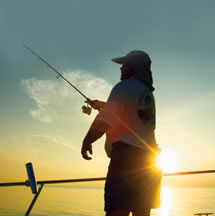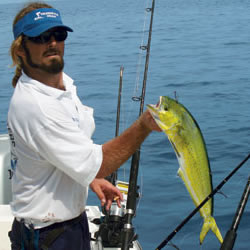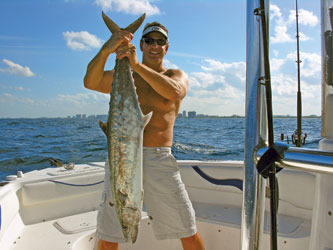May 16, 2011
By Steve Plamann
Fewer boats, good water quality and healthy reefs.
By Steve Plamann

Capt. Ed Kimmen tests a calm Atlantic at daybreak for pelagics outside Boca Inlet. |
Oh, we're in ‘em now!”
Captain Ed Kimmen raised the alarm as a spinning rod dipped sharply, the first of a cooler-filling school of dolphin.
A half-hour earlier we'd been after different quarry, trolling a variety of cut and artificial baits, when the first of two blue marlin burst across our spread. He shook his bill as if to say, “Nope, you won't catch me today!”
Later we chummed in shallower water for yellowtail snapper, catching one after the other. And while we were at it, we dropped cutbaits to the bottom and hooked several kingfish.
All this happened within four hours. It was Kimmen's way of proving a point: Boca Raton deserves to be known for something other than high-flying CEOs, plastic surgery and upscale restaurants. Fishing potential here is higher than local real estate prices.
“It's a wonderful place to fish,” Kimmen explained. “Right out of the inlet you have so many choices.”
Many South Florida anglers consider Boca a no-man's land between the bountiful waters of northern Palm Beach County and Miami-Dade County to the south.
Locals say the relatively light fishing pressure, dense reef structure and abundant nearshore bait make Boca a vastly underrated fishing venue.
A few minutes later, another marlin flashed across the lines. |
|
“People don't think of fishing when they think of Boca,” says Kimmen, who runs the charter boat Find-a-Fish (www.findafish.net). “And that's a shame because it is a diamond in the rough.”
The rough part is often boater access into the Atlantic, and that has almost certainly helped the local fish population. Boca's inlet is treacherous—with shifting sandbars that remain a challenge, even for those who use it often. Getting a big boat safely through this inlet can be worse than sitting for a root canal. (More on that later.)
While local inlet problems remain controversial, Boca's offshore waters are getting excellent reviews from local fishermen.
One of the selling points of this place is the abundance of live bait. During a recent trip we launched early out of Silver Palm Park off of Palmetto Park Road. Even before we left the dock, we saw jumping pilchards 30 feet out.
With two quick throws of the castnet, Ed filled the livewell with baitfish. “That wasn't so hard, was it?” he said.
On this dead-calm day, we had no problems clearing the inlet.
Just outside we spotted blue runners under the boat. Using small jigs, we were able to land a half dozen.
Later, while chumming for yellowtail, we nabbed a bunch of ballyhoo attracted by the tidbits.
Admittedly, conditions were ideal. It was midweek on a flat day with no other boats vying for bait.

Small dolphin, or peanuts, often invade the bait spread. |
“We're blessed,” said Kimmen, who's been fishing out of Boca for 29 years. “The amount of bait here is amazing. Live bait here is usually easy to catch. We have clearer water, the reef structure is denser and that attracts bait.”
With the livewell loaded, Ed went for big game first. He and mate Jamie Ralph quickly rigged six lines. We were in 750 feet of water just north of the inlet, trolling at about six knots. Ed let out a hoot and all heads looked astern. A big marlin was thrashing its head out of water in the middle of the spread. “C'mon! Take it,” I yelled. But the monster moved on.
Ed decided to put out a seventh line with a 6-inch strip of bonito on a 6/0 circle hook. The bait skips across the water to imitate flyingfish. “It's something I tried once and it really works,” said Ed.
It certainly seemed to work. A few minutes later, another marlin flashed across the spread lines—but again, without taking a bait. Ed was apoplectic. “That's two! We've got to get one of these!”
After a few more passes in vain to coax the marlin, Ed decided to switch tactics. “On a calm day like today, we just have to go for dolphin,” he said.
Eight miles offshore, we looked for floating weeds or debris. Several times we came up to big weed clumps, but Ed didn't like them. “I don't see any baitfish under them,” he explained. “If the weeds don't have bait, you're wasting time.”

Heed this warning! |
In 800 feet of water, Jamie spotted a floating T-shaped board, and a short distance away, dolphin. For the next half hour it was a catching frenzy as we nailed one after the other on pilchards. We kept two dolphin in the water to keep the school nearby and Jamie chummed to keep the action going. The fish were smallish, but almost all were over the 20-inch fork minimum.
Finally the dolphin left.
“Out here we can almost always find dolphin,” said Ed. “A lot of times we find them on the run home, because in the morning with the sun low, it's hard to see them.”
Then it was back to the reef. We eased into 180 feet of water and began drifting. Ed handed me a baitcasting reel rigged with an 8-ounce weight and a butterflied ballyhoo. He instructed me to drop it to the bottom, then reel up about 10 feet of line. The reel had a fast 6:1 gear ratio.
“If you get a grouper, the trick is to get him off bottom before he can reach his lair,” Ed explained.
As soon as I dr
opped deep I got a strike and quickly reeled. “That looks like a kingfish,” Ed said. Unfortunately the hook pulled.
Ed's true passion is yellowtail snapper fishing. He looks for key items: current, lots of chum and schools of these fish.
“Most people go to a spot they think might hold yellowtail and start fishing. But it's important to find the fish first,” he said.
Out here we can alomst always find dolphin. |
|
“Depending on the type of bottom unit you have, yellowtail look like triangles or pyramids off bottom. Bigger ones are deeper and smaller ones are right above them.”
A swift current is ideal. “If you don't have current, try something else,” he advises.
While most fishermen might use a box of finely ground chum, Ed uses at least two boxes of coarse chum on each side of the boat and spreads it over a large area, doing figure-eights with the boat. Instead of spreading chum in a straight line, he trolls the chum over a square area about 200 feet in each direction. Then he waits, anchoring just upcurrent from the chummed area.
“You want to give the fish a chance to find the chum,” he says. “Wait 10 or 15 minutes. The coarse chum attracts bigger fish,” he says.
We used 10- and 12-pound baitcasting outfits with 20-pound fluorocarbon leaders tied to No. 4 J-hooks. The bait was ballyhoo strips, but Ed believes in bringing a wide variety of baits when pursuing yellowtail. Besides ballyhoo and shrimp, he recommends squid, silversides, bonito and skipjack chunks.
Ed dropped a bait astern. He let it freespool with the current into the chummed area.
“You let the line go out and you know you have a fish when it suddenly goes out faster.” It happened just like he said, and a 16-inch beauty was reeled in. We quickly landed a half-dozen more, but then a midday squall chased us inside the inlet.
That night we ate superb fresh fish, without visiting those posh sushi bars in downtown Boca.

Boca fisherman Terry Lage displays a big spring kingfish. |
Boca's Inlet Woes
The city of Boca Raton dredges the mouth of their inlet about every five years. Between dredgings, the waterway does become hazardous. Hurricanes don't help. Last year the inlet became so perilous, city officials discussed closing it. Local boaters were outraged.
“People have lost their lives in our inlet,” said Gene Folden, chairman of the Marine Advisory Board of Boca Raton, which was formed in 1999 to advise the city on maintaining the inlet. “I've seen boats capsize in the inlet. I've also seen boats run aground.”
Locals haven't forgotten that in 2001, a 52-year-old man drowned in the inlet after his sailboat overturned in rough seas.

Blackfin tuna respond to chumlines in March. Local angler Mark Viau hooked this one in 62 fee. |
The issue came to a head in May of 2004 when angry boaters packed a city council meeting to demand the inlet be cleared. They told personal horror stories about using the waterway.
Many boat owners, especially those with larger vessels, say they now must head south to Hillsboro Inlet or north to Lake Worth to reach the ocean. The closest inlet north in Boynton Beach can also be dangerous and it has a fixed bridge that makes it impassable for tall boats.
As this issue of FS was going to press, a major dredging was scheduled for the mouth of Boca Inlet in mid-February, weather permitting. If all goes well, it should take about a week. Until dredging is complete, the inlet is considered “local knowledge only,” according to Folden.
“Bigger boats are using Hillsboro Inlet instead,” he says. “You can rest assured we've encouraged the city to be more aggressive and dredge on an as-need basis,” he says.
Safe Passage |
To stay safe when heading out of the Boca inlet, you can check sea conditions on an Internet Webcam. The camera allows boaters to see live wide-angle views and close-ups of the inlet. Visit: www.co.palm-beach.fl.us/webcams/bocainlet/
The north side of the inlet is shallower, so most boaters navigate through the south side where it's deeper. Turn south at the mouth of the inlet, running parallel to the beach for about a third of a mile to avoid the shoal. Turn east at the third condo building to head out into the ocean. Be aware that the shoal regularly moves, so watch for the sandbar before turning east. The north jetty is damaged from recent hurricanes and repairs haven't been started yet, according to Gene Folden, who is on Boca's marine advisory board.
|
|
The inlet controversy pits boaters against the owners of pricey homes on the beach. Beachfront residents want the city to keep their beaches fat and wide with regular sand renourishment projects. That very sand pumped in from offshore creates dangerous inlet shoals.
“Renourishment is a great part of the problem,” says Folden. “The city tends to put people who live on the beach first. But they need to set funds aside to keep the inlet safe.”
The city now spends about $462,000 a year to dredge inside the inlet. Several days a week, sand is pumped from inside the inlet to the beach directly south. But that does nothing to open the mouth of the inlet.
The bottom line: Beach renourishment and big storms equal big trouble for Boca Inlet.
In 2004, a beach renourishment project pumped 478,000 cubic yards of offshore sand onto 1.5 miles of Boca shoreline. That sand hadn't even settled when hurricanes Jeanne and Frances blasted through and left the sand near the mouth of the inlet for area boaters, a threat to navigation and life itself. Beach residents were upset because the storms washed away an estimated two-thirds of their sand, a huge waste of time and money.
Bill Fenner, a captain with Sea Tow, has been rescuing boaters from Boca's inlet for six years. He was involved in the rescue effort in the 2001 inlet drowning.
“I'm really upset at the city,” he says. “Common sense isn't prevailing. They need to dredge every 3 to 5 years, instead of 5 to 7. Otherwise, one of these days there will be another fatality.”
Before the scheduled 2005 dredging, Fenner says the inlet was unsafe for boats with more than a 4-foot draft. Part of what makes the inlet so difficult to navigate is that the position of the ebb shoal can be unpredictable, moving with each storm.
“The local captains know how to do it, but it's tricky,” says Fenner.
FS

